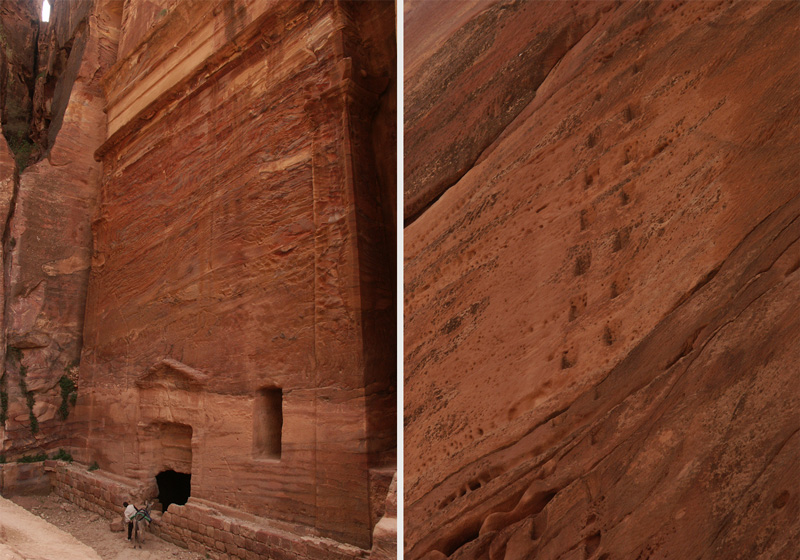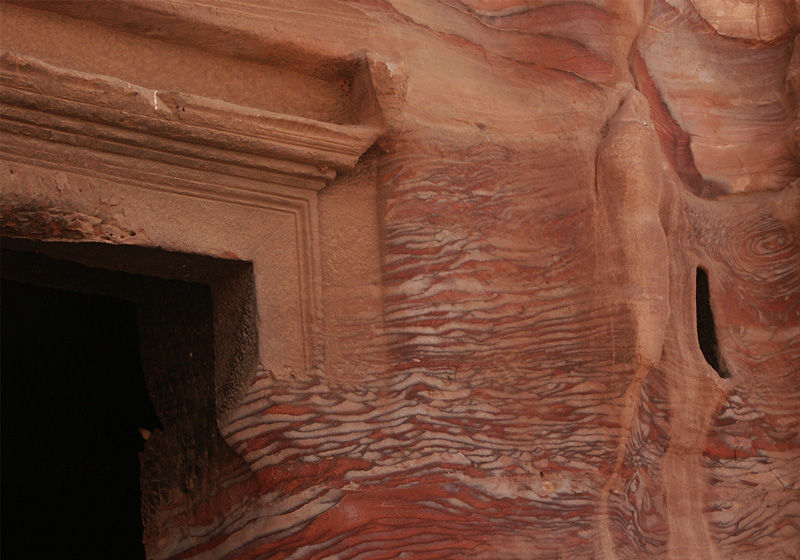Time Halt
It was not until the Renaissance, in the 15th century, that the west began the tradition of giving architectural works a personal signature. While this deliberate celebration of individual creativity has became the norm since then, the Nabataean tradition in Arabia had been following the practice for 2000 years.
The celebrated Nabataean family of stonecutters best known from their works in Medain Saleh in Saudi Arabia –Wahballahi and his son ‘Abd’obodat- worked and signed many tombs as chief stonecutters. Spanning two generations, this school of stonecutters represents an average life of 25 productive years for each generation: the total working life for the two generations would be fifty years (1-50 AD).

ʻʻGifted Wahballahi (who’s name might be translated as “the gift of God”) was using dark mineral powder to mark some guiding-lines on the uncut rock as the rest of his stonecutting team were busy carving the pink sandstone. His son Abd’obodat stepped into the shade of the unfinished east-facing elevation and entered under the scaffolding of juniper tree trunks. The master stonecutter preferred a short break in the alcove of the finished upper part of the tomb between the capitals. Here it was cool as the freshly cut rock was still slowly emitting soothing moisture. Climbing with his fine-tuned Arabian body, Abd’obodat reached his father with ease and handed him a cloth bundle containing some raisins, a few dried figs, and a small pot of cooked meat.
It was now just after midday and the chisels were singing as they drove their teeth into the mountainside. While young 'Abdo' is watching his father, a man arrived at the construction site with some urgency. He called the chief stonecutter down while 'Abdo' picked up his father’s tools and continued the work. After a short conversation, the chief stonecutter returned to the scaffolding and asked the workmen to stop. The ringing of iron gradually halted ending with a single last strike –it was like the sudden silence of birds in a tree upon the signal of eminent danger.
As the last stonecutter stepped down, Wahballahi declared work on the tomb postponed indefinitely, and at the same time released his workers who started walking back home. The silence of the chisels and the indefinite date stretched out to this day, and further into eternity.ʼʼ

Although Wahballahi and his son Abd’obodat are real people, on whom archeologists and historians have some data revealing aspects of their life and profession, the scene described above is only an educated reconstruction of a working day in the life of Nabataean stone-cutters. It is not based on any record connecting those carvers to any specific unfinished monument. Credible scenarios for unfinished tombs would include the stopping of funds; the financier's death and his sons' decision not to invest in their father’s memorial endeavors. Or, maybe the client decided on an elevation of a different design, and found a more prominent rock-face for it. Also, the chief cutter might have been summoned by the king to immediately start work on the Urn Tomb or the Palace Tomb, for example.
There are a few unfinished tombs, and I know of two in Petra alone: A small early one shortly before the Obelisk Tomb with its ‘crowsteps’ visible on an upper rock to the north of the walkway. There is also the other more famous and larger façade behind Qasr al Bint.
Many consider the unfinished tombs more important than many of the finished ones. Besides being more rare, unfinished tombs provide us with information about the process of building (or cutting) these monuments.
Imagine someone had a box camera 2000 years ago –one of these older, simple cameras with a large glass- negative and hardly any lenses, and imagine that this Nabataean photographer secretively took a snapshot to document the making of a monument while being cut. The snapshot would freeze time, arresting the monument in a split second and preserving its unfinished carving for the next thousands of years.
In a way, unfinished tombs are a sort of ancient photographs (or petrography, for a better word) 2000 years old. They represent a kind of three-dimensional frozen image of a specific time and process, in which all the elements of the composition were preserved. Instead of only a two-dimensional profile of reflected light as in usual photos, here we have a tangible reality, a physical composition, where time was made to stop.
Petra should be revisited time and time again. For continuing enjoinment, you can preplan your visit, probably giving it a specific theme based on some readings. I find is extremely energizing, to read about one specific aspect of the Nabataean civilization and then make a trip specifically to apply the text to reality. Go beyond the commercial photography-centric Petra books often found in different languages in souvenir shops. These books are of little use, as they mostly show you the monuments that you will see in reality anyway. The book “Petra” by Iain Browning is very informative and reader-friendly. If you are looking into more technical architectural data check “the Architecture of Petra” by Judith McKenzie. Slow down your tour of Petra, we usually rush into this important site and pass in front of its features too fast - it’s a bad habit that diminishes our understanding and enjoinment of the site’s natural and archeological features. It is also exhausting to both the visitor and the sanctuary.